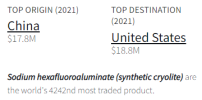Viet
ELITE MEMBER

- Joined
- Jun 18, 2012
- Messages
- 29,950
- Reaction score
- 0
- Country
- Location
The government plans to mine for bauxite, the ore used to produce aluminum, at three new locations in the north.

Tan Rai aluminum project in the Central Highlands province of Lam Dong. Photo by VnExpress/Khanh Huong
It plans to develop by 2030 one site in Lang Son Province and two in Cao Bang, the Ministry of Industry and Trade said Wednesday.
Their combined capacity will be within 1.55-2.25 million tons of ore annually.
Besides, at least two existing mines in Lam Dong Province in the Central Highlands will be upgraded to increase production.
The gov also explores the possibilities of mining 68-112.2 million tons of bauxite annually in four central highlands provinces.
At 5.8 billion tons, Vietnam has the world’s second largest bauxite reserves behind only Guinea (7.4 billion), according to the U.S. Geological Survey.
The majority of bauxite in Vietnam is found in the Central Highlands, especially Dak Nong Province.

 e.vnexpress.net
e.vnexpress.net

Tan Rai aluminum project in the Central Highlands province of Lam Dong. Photo by VnExpress/Khanh Huong
It plans to develop by 2030 one site in Lang Son Province and two in Cao Bang, the Ministry of Industry and Trade said Wednesday.
Their combined capacity will be within 1.55-2.25 million tons of ore annually.
Besides, at least two existing mines in Lam Dong Province in the Central Highlands will be upgraded to increase production.
The gov also explores the possibilities of mining 68-112.2 million tons of bauxite annually in four central highlands provinces.
At 5.8 billion tons, Vietnam has the world’s second largest bauxite reserves behind only Guinea (7.4 billion), according to the U.S. Geological Survey.
The majority of bauxite in Vietnam is found in the Central Highlands, especially Dak Nong Province.

Vietnam aluminum mining to increase exponentially - VnExpress International
The government plans to mine for bauxite, the ore used to produce aluminum, at three new locations in the north.
 e.vnexpress.net
e.vnexpress.net





